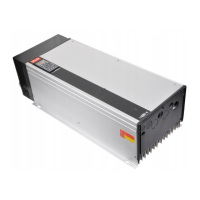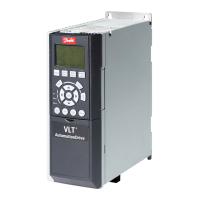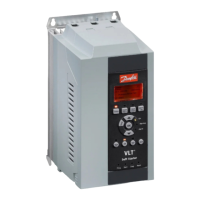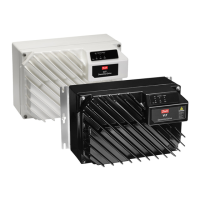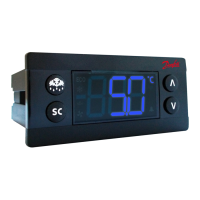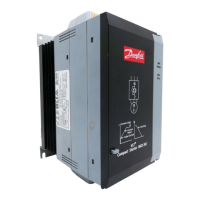VLT
®
2800 Series
Programming
NB!:
If the frequency converter is running a the
current limit before the required start fre quency
is obtained, the process regulator will not be
activated. For the reg ulator to be activated anyway, the
start frequency must be lower to the required output
frequency. This c an be done during operat ion.
440 Proces PID proportioanl gain
(PROC. PROP. GAIN)
Value:
0.0 - 10.00
✭ 0.01
Function:
The proportional gain indicates the number of
times the deviation between the setpoint and the
feedback signal is to be applied.
Description of choice:
Quick regulation is obtained by a high gain, but
if the gain is too high, the process may become
unstable due to overshoot.
441 Process PID integration time
(PROC. INTEGR. T.)
Value:
0.01 - 9999.99 (OFF)
✭ OFF
Function:
The integrator provides an increasing gain at a
constant error between the reference/setpoint and the
feedback signal. The greater the error, the quicker
the integrator frequency contribution will increase.The
integral time is the time needed by the integrator to
make the same change as the proportional gain.
Description of choice:
Quick regulation is obtained at a short integral time.
However, this time may become too short, which can
make the process unstable due to overswing. If the
integral time is long, major deviations from the required
setpoint may occur, since the process regulator will
take a long t ime to regulate in relati on to a given error.
442 Process PID differentiation time
(PROC. DIFF. TIME)
Value:
0.00 (OFF) - 10.00 sec.
✭ 0.00 sec.
Function:
The differentiator does not react to a constant error.
It only makes a gain when an error changes. The
quicker the deviation cha nges, the stronger the ga in
from the differentiator. The gain is proport ional to
the speed at which the deviation cha nges.
Description of choice:
Quick regulation is obtained with a long differentia t i on
time. H owever, this time may become too long, which
can make the process unstable due to overswing.
443 Process PID diff. gain limit
(PROC. DIFF.GAIN)
Value:
5.0 - 50.0
✭ 5.0
Function:
It is possible to set a limit for the differentiator gain.
The differentiator gain will increase if there are fast
changes, which is why it can be beneficial to limit this
gain. Thereby a pure differentiator gain is obtained
at slow changes and a co nstant differentiator gain
where quick changes to the deviation o cc ur.
Description of choice:
Select a differentiator gain limit as required.
444 Process PID lowpass filter time
(PROC FILTER TIME)
Value:
0.02 - 10.00
✭ 0.02
Function:
Noise in the feedback signal is dampened by a first
order lowpass filter to reduce the noise’s impact on
the process regulati on. This can be an advantage
e.g. if there is a lot of noise on the signal.
Description of choice:
Select the required t ime constant (t). If a time constant
(t) of 0.1 s is programmed, the cut-off frequency
for the lowp ass filter w ill be 1/0.1 = 10 RAD/sec.,
corresponding to (10 / 2 x π) = 1.6 Hz. The process
regulator will thus only regulate a feedback signal
that varies by a frequency lower than 1.6 Hz. I
fthe
✭
= factory setting. () = display text [] = value for use in communication via serial communication port
MG.28.E9.02 - VLT is a registered Danfoss trademark
105

